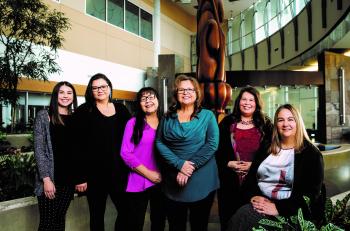Image Caption
Summary
The Stollery Awasisak Indigenous Health Program at the University of Alberta Hospital is helping to build bridges between young Indigenous patients and their home communities.
The team at Awasisak (which is Cree for “many children”) held an open house on Nov. 21 to recognize and celebrate the program, which is the only one of its kind in Canada.
The Stollery Awasisak Indigenous Health Program was created in 2016 to build bridges for Indigenous children coming to the Stollery.
“It's really about discharge planning,” said Sherri Di Lallo, a registered nurse who is the Indigenous Team Lead at the Stollery Children's Hospital (the part of the University of Alberta Hospital that deals specifically with children). “Our medically complex care children need extra support and services in place.”
Fifty per cent of the children in the Stollery are from outside Edmonton. Thirty-five per cent of those children are Indigenous. They range in age from newborns in the neonatal intensive care unit to age 17.
Indigenous Child and Family Engagement Coordinator Chrystal Plante helps young patients and their families, some of whom only speak Cree, get familiar with their surroundings.
“I can be that friendly face for them and get them familiar with their surroundings. I can take them on tours of the hospital. I can also access outside resources and take them to facilities outside of the hospital, like Bent Arrow (Traditional Healing Society),” she explained, adding that she also tries to help connect children and families with cultural supports as well.
Di Lallo emphasizes that the program also builds a bridge between Alberta Health Services and Indigenous patients in terms of understanding rural and remote communities, and how there was a disconnect between AHS staff understanding the real world for Indigenous populations (First Nations, Métis, and Inuit).
“Some of our families have to travel up to 1,000 km away. It's really important they understand that distance.”
The program also acts as a liaison between the patients and their home communities.
“A lot of our children get discharged on a Friday afternoon, so the nurses in the communities don't really know that these children are being discharged,” Di Lallo explains. “Our team starts working at the beginning of the week to have time to connect with the community, to have services put in place for that child to be successful at home to prevent readmission. Just that simple communications strategy of the nurses in that community knowing the children are coming home takes a lot of stress off of them.”
Ensuring that the transition back home is smooth also involves making sure that the young patients' prescriptions are filled at the Stollery. A scenario described by Di Lallo involves taking a 10-hour bus ride home, going to a community pharmacy, and being told that a children's dose of the medication is not readily available.
Talking circles have helped shape the program. In 2017 and 2018, the Stollery hosted 12 talking circles with more than 160 participants from 32 different First Nations and Métis communities.
“We really believe the talking circles is a vision day to provide opportunities to hear Indigenous voices offering Indigenous solutions regarding how to improve care for children at the Stollery,” said Di Lallo.
The program also makes strategic partnerships, such as with Ronald McDonald House to provide housing for families from out of town, when available. Careers Next Generation provides an Indigenous Health Science Academy, hosting teenage students at the hospital to interact with staff who introduce them to a variety of health careers.
“The goal is they will get their education and go back and serve their communities,” Di Lallo explains.
Another initiative currently under development is an outreach team to service the north, as well as helping build capacity for health care professionals in remote communities, so children don't have to keep returning to Edmonton for follow-up appointments.
The Open House featured tours of the Awasisak office, talks from various people involved with the program, and musical performances.

